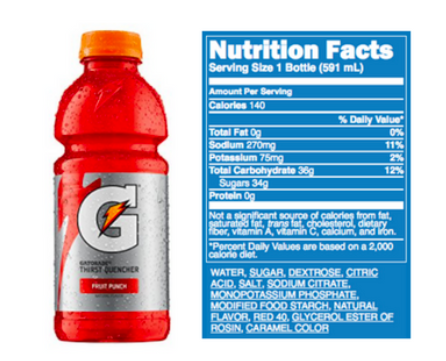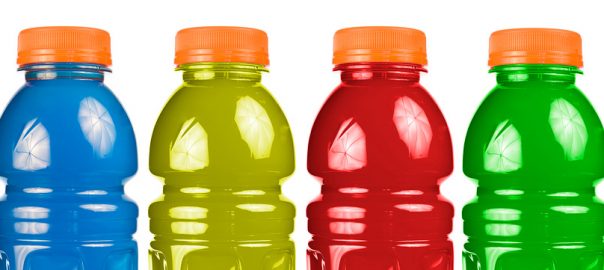I'm going to be blunt. Under no circumstances would I recommend commercial sport drinks. Period. Well, maybe if you are dehydrated (literally) and no other liquid exists for miles.
Sadly commercial sport drinks such as Gatorade and Vitamin Water are nothing but liquid sugar and chemical additives. The cons far outweigh any benefit. Most young children simply need water. Teenage and adult athletes may need extra support, but there are much healthier alternatives. And I guarantee professional athletes are not drinking Gatorade despite the advertisements you see on TV.
A Closer Look at the Ingredients in Sport Drinks
While there are minor differences in different sport drinks, many of them have the similar ingredients. Let's take a closer look at the ingredients in Gatorade…

Water: Good!
Sugar: And lots of it! An entire 16-ounce bottle contains a little more than 13 teaspoons of sugar. It's counterproductive to encourage our kids to play sports to be healthy, but then load them up with sugar. Sugar sweetened beverages (SSBs) are the primary source of added sugars in the standard American diet. And several studies have linked SSBs to weight gain, obesity, type 2 diabetes and heart disease [1].
Dextrose: Just another form of sugar. Unfortunately this form of sugar is made from corn and therefore most likely to be genetically modified (GM).
Citric Acid: A flavoring and a preservative. It may seem harmless because it is naturally found in fruit, but the citric acid found in foods and beverages is chemically produced from black mold secretions. It's also another product that comes from corn and another source of GM contamination.
Natural Flavor: Don’t let the name fool you. The “fruit punch” does not get its flavor from real fruit. These are flavors made in a laboratory. And no one really knows how or what is used to make them.
Salt: Salt is one of the electrolytes (the other major electrolytes are calcium, chloride, magnesium, potassium, and phosphate) however sea salt would be a better option here because it actually provides minerals.
Sodium Citrate: A “sodium salt of citric acid” this chemically processed food additive is used to regulate acidity. It has a potential to cause allergic reactions, dizziness, or restlessness.
Monopotassium Phosphate: This ingredient is a potassium salt that has the potential to cause abdominal discomfort. It's a common food additive as well as a fertilizer and fungicide.
Modified Food Starch: Another chemically processed food stabilizer.
Red 40: Artificial dyes are linked to behavior disorders and hyperactivity in children. Some kids are more sensitive than others. For those that are sensitive, it can be disastrous for them and their families. These dyes are made from petroleum and coal tar and are banned in several other countries. [2]
Glycerol Ester of Rosin: A food additive designed to keep oils suspended or evenly mixed in water. It is produced from pine tree wood rosin using a long list of chemicals.
Caramel Color: Another artificial coloring additive. Unfortunately it contains 4-methylimidazole which has been linked to cancer.
Unfortunately the “zero-calorie” options typically contain the exact same ingredients. However instead of sugar, they use artificial sweeteners. While many people turn to artificial sweeteners to consume fewer calories, studies have actually linked them to weight gain. [3]
Healthy alternatives
There are more “natural” brands on the market today, but they’re mostly made of concentrated fruit juice (another form of liquid sugar). And they still have a few unnecessary additives. Therefore, why buy over-sugared drinks when water is a much healthier, and cheaper, option.
And from an environmental standpoint, we’d use much less plastic if every team player brought a reusable water bottle filled from home. Further, you'll also your reduce exposure to the harmful aspects of plastic by using a glass or stainless steel container.
While one sport drink won’t cause permanent harm, drinking them routinely is another story.
When you or your children truly need a source of electrolytes after an intense or prolonged period of physical activity, try one of these options instead:
- Make your own electrolyte drink by combining water, lemon, raw honey and sea salt
- Make an agua fresca
- Choose coconut water, a well balanced electrolyte beverage (but, be sure to read the label and avoid harmful additives)
Containers
One other issue with sports drinks and vitamin waters is that they come in a plastic container. This is a problem due to the BPA (to learn more watch my interview with Lara Adler, The Environmental Toxins Nerd). Bring your own drinks with you and use glass or stainless steel containers as your healthiest option. My personal favorite is Glasstic, a shatterproof plastic cylinder around a glass center cylinder. Easy to take apart and wash in the dishwasher, the company claims these are the last water bottle you'll ever need. I bought three over a year ago and they're still going strong. Get 10% off with this link.
* * * * * *
Resources:
[1] Sugar Sweetened Beverages: Over time, too much liquid sugar can lead to serious disease
[2] Food additives and hyperactive behavior in 3-year-old and 8/9-year-0ld children
[3] Gain weight by “going diet?” Artificial sweeteners and the neurobiology of sugar cravings


